Final Report for FNC15-1015
Project Information
Integrated farm systems contribute to sustainability in multiple ways on the farm. The Coop House project attempts to integrate poultry production with winter vegetable production. The schedules are complimentary here in the Midwest, so that these enterprises allow for year round income for the farmer. Indeed, they allow the sale of winter vegetable crops with chicken harvested from the summer season and frozen, creating the possibility for a mixed meat and vegetable CSA offered year round, which helps with continuity of marketing and customer loyalty. We did not attempt to offer a CSA during the time of this experiment, but may try one in the future as our farm gets a solid schedule worked out with vegetable and poultry integration. These houses are built on such a scale that they are best tailored for a farm business that aims to sell poultry largely in the retail market, not necessarily on the wholesale scale. The use of pastured poultry also contributes to the health of the soil on the farm, increasing soil organic matter and other nutrients for the crops following.
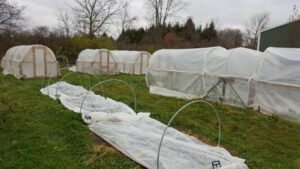
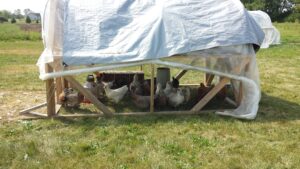
Introduction:
The coop house concept is overall most fitting to a smaller farm operation, although it could be expanded using a larger movable structure. As a winter low tunnel in Indiana, the two winters we tested this model were pretty successful. Cold hardy crops such as kale and spinach were harvest-able the entire winter with the addition of a frost protection cloth inside the house. The coop house used as a hoop house or low tunnel, performs much the same as other unheated greenhouses, having some significant temperature fluctuations in the early spring when the weather is variable, but generally averaging one zone south in its growing capability. The fact that the greenhouse is movable was a distinct advantage in controlling pest populations. There was no build up of aphid or other typical greenhouse pests because the houses were rotated off of the greenhouse beds in the summer and different field crops were grown in the place of the winter greens, adding to the rotational diversity.
The mobile “coop house” is a versatile design well suited to a small farm and/or urban market garden setting. It allows the farmer to utilize the house for chickens in the summer and high tunnel type growing in winter with very low input costs to build. The ability to move these houses has been a significant advantage for pest population control and for controlling exactly where the chicken manure is applied to the field. In our case, we move the chicken houses between rows of blackberries in early spring and through fields that we plan to rotate into vegetables in the next two years.
The farm can also respond to the current business climate, especially in winter, by utilizing the houses for more vegetable growing or for overwintering egg laying flocks depending upon demand. We experimented with both, finding that the greenhouse makes for an excellent heater to keep a flock of egg layers warm in winter as well as allowing for a lot of light to stimulate egg production. We built 8 houses, 2 of which we used for overwintering chickens in 2015 while the other six were connected together to form three 26ft by 6ft high tunnels in which we planted kale, spinach,lettuce, arugula, chard, mustards and salad mix. Following a schedule of early fall planting and harvesting mature crops over the winter worked the best. We replanted some lettuces in early spring, allowing us to harvest a month earlier than the field grown lettuces before putting tarps over the tops of the houses and using them for chicken production again. This year, we will experiment with using one or two of the houses to get an early start with heat loving crops while raising a batch of meat chickens with the other houses.

Our objective was to have a versatile system that integrated pastured poultry with vegetable production. The coops had to be moveable and yet combine together to be a large enough growing area to work in during the winter. We feel that these objectives were met with success. The pens worked well for pastured poultry, were easily movable and helped us control exactly where the manure was applied. This allowed us to fertilize between rows of brambles safely. The pens also serve as a decent, low cost high tunnel, tall enough to work in, but small enough to manage easily with hand tools and to rotate beds for winter market gardening.
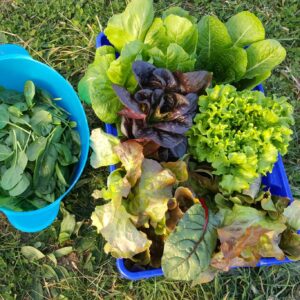
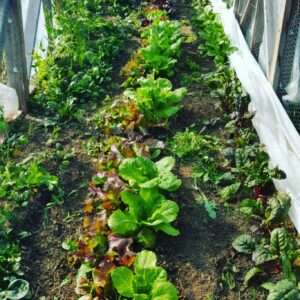
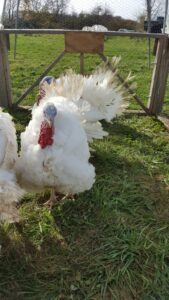
Cooperators
Research
The coop house was used for chickens in the spring/summer and a batch of turkeys in the summer/fall. After the houses were done with raising poultry, they were power washed and then pushed over pre-planted fall greens. Several of the beds we used the first year had chickens on them in the early spring, were rotated to a cover crop in the summer and then planted with winter greens in the fall. This allowed us to safely harvest the nutrients the chickens left behind in the cover crop while still maintaining the right amount of time for active decomposition of the manure the chickens left behind in the soil.
The ends of the houses come apart so that two can be joined together to make one larger hoop house, with both ends sliding over the crops on either side so as not to damage pre-planted greens. In the spring after a March harvest of lettuces, the houses are pulled back apart again. We tested the soil in the field both in the area the chickens had not been and in the area they were moved over for two years in a row. We kept the chicken areas in pasture for both years of this project to measure more than one year of soil impact. In addition to the winter greenhouses, two of the structures were used in the winter of 2015/2016 to house a flock of egg laying chickens in a winter pasture. Having these houses movable for winter is an advantage as well, so that winter pastures can be rotated as well as summer, contributing to better pasture management and not quite so much damage from the chickens being in one place all winter (as they were before in our insulated coop). The greenhouse stayed warm with solar gain and the addition of 6 inches of straw and alfalfa hay on the floor of the house. We added roosting bars and nestboxes on the back and sides of the house respectively to convert the house to one suitable for hens. In the winter of 2016/2017 we decided to use only one house for egg layers and use the second one for more winter vegetable production. In this case, we attached the greenhouse to the south side of our permanent winter coop to act as a solar heater for the coop and give the chickens a warm space to scratch in when the weather is bad. This has been pretty successful. We have had zero need for supplemental heat in our coop this winter, giving us electrical savings during a time when the hens are less productive.
The design could be improved by adding an automatic venting system at the top when it's in use as a greenhouse. When used as a mobile coop, we found that the corners needed reinforcing as we moved it and that the addition of cleats with wheels also made it much easier to move.
One thing we learned in 2016 was that these houses are not ideal for brooding chickens. We thought that the solar gain would be good for helping reduce heating costs in the brooder. What we didn’t anticipate was the difficulty of temperature control or the problems that would arise when the spring was very wet and the floor of the brooder would be too wet for baby chicks. This year we will return to our previous system of brooding in a controlled indoor environment in the barn and then moving the chicks to the pastured houses after they’ve reached about 3 to 4 weeks of age.
The pastured poultry contributed to significant soil improvements for the pastures in which we used them. Attached is the soil testing from 2015 and 2016 to show one- and then two years of poultry on these pastures. The samples were taken using a soil core sampler at approximately 8inches of depth, with 5 samples blended together for each of the results. The chicken pasture area is right next to the non-chicken area, both being planted in a mixed legume and grass pasture. In 2015, the sample number 1 was from the non-chicken area and sample 2 had chickens. In 2016, the sample 1NC was the non-chicken area and sample 2C was chicken (the G sample is not part of this report, it was taken from the garden). Overall, chickens contributed to an increase in the CEC. Also phosphorus and potassium levels in the soil increased in a soil containing very low levels of phosphorus to levels considered high. See attached soil tests. SARE_GRANT_PROJECT_F17024_0010 (3) projects.sare.org/…/BERRY_GOODS_FARM_SARE_SAMPLE_1_F15246
Impact of Results/Outcomes
Our newly established farm was able to double our sales from the year before this project to the year we started the project and the subsequent year. The houses contributed a steady stream of income through the winter from greens sales, allowing better cash flow for our farm through a typically lean time. They also allowed for continuity so that we now have year round regular customers. We have the capacity to raise a lot more poultry in these houses than we did during the project time. We raised 200 chickens and 15 turkeys per year, but could have raised a total of 400 chickens and 60 turkeys per batch if we had been able to sell them quickly enough. What we found was that the limitation was freezer space to store the meat until the birds are sold. As we slowly build our operation, we can invest in more freezer space to increase our meat sales or gather a following of customers who pick up the meat the day it is butchered. The same could be said of the greenhouses. We could have grown a bit more intensively than we did, but we lacked the cool storage space to do so. In future years, this project will allow us to have the capacity to grow more as we build more infrastructure on our farm.
Educational & Outreach Activities
Participation Summary:
I presented a poster at the 2015 Indiana Small Farm conference and was able to share this coop house idea with many like-minded farmers and researchers. There was general overall enthusiasm for an integrated system such as this one. Attached is a file with the poster I presented.
I also have a blog on my website www.berrygoodsfarm.com detailing this project and including the progress report and the final report and I have been posting periodic updates on my Facebook, Instagram and Twitter accounts that I use for Berry Goods Farm.
.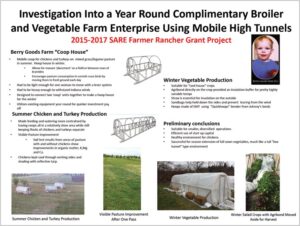
Project Outcomes
Potential Contributions
This project is a contribution to the concept of an integrated farming system. The integration of poultry in vegetable operations is one that can be done safely and effectively with proper management, contributing to the health of the poultry and the soil fertility on the farm at the same time. The system also allows for farm diversification, which is a wise strategy to utilize for minimizing risk in the farm business.
Future Recommendations
Future recommendations from this project would be to investigate larger structures for poultry and greenhouse integration. I think that there is a lot of promise in the idea of using movable greenhouses on the farm to help solve pest control problems. Integrating this with poultry systems is the next step in fertility and pest management.